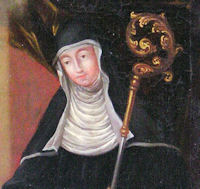St. Walburga
Historically today is the feast of St. Walburga, sister of Sts. Willibald and Winebald. She became a nun at Wimborne in Dorset under St. Tatta and followed St. Lioba to Germany at the invitation of St. Boniface. She died abbess of Hiedenheim, whence her relics were translated to Eichstatt.
St. Walburga was born in Devonshire England, around 710. She was the daughter of a West Saxon chieftain and the sister of St. Willibald and Winebald. Walburga was educated at Wimborne Monastery in Dorset, where she became a nun. In 748, she was sent with St. Lioba to Germany to help St. Boniface in his missionary work. She spent two years at Bishofsheim, after which she became Abbess of the double monastery at Heidenheim founded by her brother Winebald. At the death of Winebald, St. Walburga was appointed Abbess of both monasteries by her brother Willibald, who was then Bishop of Eichstadt. She remained the superior in charge of both men and women until her death in 779. She was buried first at Heidenheim, but later her body was interred next to that of her brother, St. Winebald, at Eichstadt.
For some reason an aromatic fluid with healing qualities began to flow (and still flows) from a fissure in a rock on which their tomb stands. Its healing powers were attributed to her, and the fluid became known as St. Walburga's Oil. was seen as a sign of her continuing intercession. The oil has always been collected and given to pilgrims. Healings attributed to St. Walburga's intercession continue to be reported up to the present day.For more information on St. Walburga, see Fr. Nicholas Schofeld's post at Roman Miscellany.
Patronage: against coughs, dog bites, famine, hydrophobia, mad dogs, rabies, and storms; for sailors, harvests, and mariners; Anterwerp, Belgium, diocese of Eichstätt, Germany, Gronigen, Netherlands,Oudenarde, Belgium, diocese of Plymouth, England, Zutphen, Netherlands.
St. Walburga was born in Devonshire England, around 710. She was the daughter of a West Saxon chieftain and the sister of St. Willibald and Winebald. Walburga was educated at Wimborne Monastery in Dorset, where she became a nun. In 748, she was sent with St. Lioba to Germany to help St. Boniface in his missionary work. She spent two years at Bishofsheim, after which she became Abbess of the double monastery at Heidenheim founded by her brother Winebald. At the death of Winebald, St. Walburga was appointed Abbess of both monasteries by her brother Willibald, who was then Bishop of Eichstadt. She remained the superior in charge of both men and women until her death in 779. She was buried first at Heidenheim, but later her body was interred next to that of her brother, St. Winebald, at Eichstadt.
For some reason an aromatic fluid with healing qualities began to flow (and still flows) from a fissure in a rock on which their tomb stands. Its healing powers were attributed to her, and the fluid became known as St. Walburga's Oil. was seen as a sign of her continuing intercession. The oil has always been collected and given to pilgrims. Healings attributed to St. Walburga's intercession continue to be reported up to the present day.For more information on St. Walburga, see Fr. Nicholas Schofeld's post at Roman Miscellany.
Patronage: against coughs, dog bites, famine, hydrophobia, mad dogs, rabies, and storms; for sailors, harvests, and mariners; Anterwerp, Belgium, diocese of Eichstätt, Germany, Gronigen, Netherlands,Oudenarde, Belgium, diocese of Plymouth, England, Zutphen, Netherlands.





Thank you for posting this. She is my patron saint. I first noticed her, before I became a catholic, on a triptych in Belgium. I was fascinated by the woman holding a book with a vial on it, with a bishop's crook in the other hand. The bishop's crook, of course, symbolizing the fact that she was the equivalent of a bishop in rank as abbess of men and women. She also holds a vial of medicine in her images because she was a healer, a doctor of sorts in the 8th century. A wonderful, strong celtic missionary who should be right up there with St. Patrick, St. Brigid, St. Brendan, et al.
ReplyDeleteAMDG